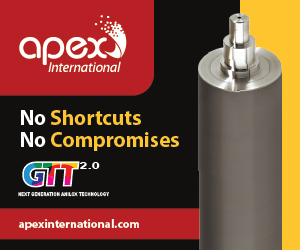Featured Stories
-
Elevating Pouch Manufacturing with Pearl Technologies' Cutting-Edge Solutions
For manufacturers seeking efficiency, precision, and safety in pouch production, Pearl delivers unmatched innovation across three standout... -
Faster Product Composition Analysis Equals Better Quality Assurance
Near Instant Testing and Reduced Costs to be Found -
Methods to Precisely Measure Tension and Web Control
How to Control Automatically Within Set Parameters
News | New Products
-
Convertech Brand to Fully Transition to Double E Group Same Team, Same Excellence, Unified Name
Double E Group has announced that Convertech, one of its subsidiaries and a trusted provider of core chucks and shaft solutions for the converting industry, will now operate solely under the Double E Group brand.
-
Pulse is Making Print Simple at Labelexpo Europe 2025
Narrow web ink specialist Pulse is Making Print Simple at Labelexpo Europe 2025, as it challenges flexo printers to rethink how they work and shows solutions that turn production bottlenecks into revenue generators.
-
ROTOCON to debut at Labelexpo Europe with three machine demonstrations
ROTOCON will make its Labelexpo Europe debut, exhibiting together with HS Machinery on stand 4D21.
-
At Interphex Japan, IL Group to Showcase Innovative Labeling Solutions and Contract Packaging Services
IL Group, a specialist in multifunctional labeling solutions for the pharmaceuticals and healthcare sectors
-
Revolutionizing Adherence: Clinical Trials Go Digital with Enhanced Key-Pak®
Keystone Folding Box Co., a leading provider of paperboard packaging solutions, has announced a strategic partnership with Med-Con Technologies
-
Innovating for Circularity: How New Sustainability Initiatives Are Shaping the Future of Labeling
In the face of growing regulatory, environmental and consumer pressures, the packaging and labeling industry continues to advance technologies and solutions that help to support a circular economy.
-
New Product Development: RKW Horizon®–MDO-PE Films with EVOH Barrier
RKW Horizon® is the new generation of sustainable PE plastic films based on the latest MDO technology.
Expert Advice
Regulation, competition drive the adhesives industry
- Published: February 01, 1996, By Mykytiuk, Andrew
Perhaps the biggest reason for the rapid change in the adhesives business is the Environmental Protection Agency's push to eliminate volatile organic compounds (VOCs). Due to these restrictions, the raw materials used as the basis for today's adhesives are very different from those of a decade ago. The converting industry is extremely broad, encompassing many different applications and processing a myriad of materials. And because there is no universal "one-size-fits-all" adhesive, the race is on to formulate a product that will at least equal the performance of these restricted solvent-based adhesives. "The most important thing that happened to the adhesives industry was the EPA forcing converters away from solvent-based adhesives toward the development of waterborne, hot melt, and hybrid systems," says Bill Klein, president of BFI, Springfield, OH, and author of the book They Built an Industry, the history of the pressure-sensitive label industry.
"Despite 15 years of development [of alternate systems], there are still a lot of solvent-based adhesives in use today in producing laminate for flexible packaging, probably more than all the others combined," adds Bart Twomey, business director for North America of Novacote International, Naperville, IL. According to Twomey, one of the reasons for this slow adoption is that water-based adhesives remain difficult to use. The debate between solvent- and water-based adhesives boils down to a question of reliability and batch-to-batch consistency. Solvent systems have been around since 1960 and have become very reliable and very consistent. Water-based adhesives have been around for a much shorter period of time, and the improvement in performance is ongoing. "Today's water-based adhesives can do half the jobs that solvent-based adhesives have been traditionally used for, and every year they can do a little bit more," says Twomey. "I would say that in five years there will only be a few limited applications where water-based adhesives cannot be used."
Twomey explains that solventless or 100% nonvolatile laminating adhesives offer converters great flexibility, but when these are hot applied there is a limit to the temperatures the substrate can be exposed to. Polyethylene stretches at temperatures above 120 deg F, and, with a material such as oriented polypropylene, you start to get significant shrinkage at 160 deg F. With today's warm-applied systems, developed three to four years ago, the application temperatures are a mild 130 to 140 deg F, there is a 20-minute window in case of machine stoppage, and there is improved green bond. "The warm-applied, solvent-free system offers the greatest versatility," says Twomey. "We've run these things at 300 meters per minute or more, and the limitation is the mechanical capability of the machine."
UV is Coming
"The adhesive application system that holds the greatest promise is ultraviolet and radiation-cured, because application and cure are done in-line at high speeds," says Dick Muny, president of Chemsultants, Mentor, OH.
Muny's company has spent ten years developing alternate environmentally friendly products for the converting industry that are not just adhesives but paper, film, and foil constructions.
According to Muny, one of the major innovations of the past decade is testing. "In the old days the marketplace itself was the testing lab. They made something, sent it out, and if it stayed sold, they had a success. Today, sophisticated testing has made it possible to predict performance before ever releasing an adhesive into the field, so the batting average with new products has gone from 75 percent in the old days to a 95 percent success rate today."
Twomey doesn't see a revolutionary adhesive product on the horizon; what he does see is improvement and refinement of what already exists. "I think solvent-based adhesives are going to be with us for at least another 15 years but with a declining share of the market. You might see solvent-based adhesives taking 5 percent of the market instead of the 50 to 60 percent today," says Twomey. Muni says the adhesive is usually the cheapest part of the construction, between 1 and 4% of raw material cost, but can cause the most expensive failure. That is why the research into the chemistry of adhesives continues at a relentless pace.





















